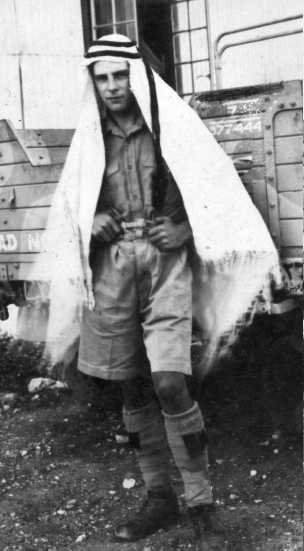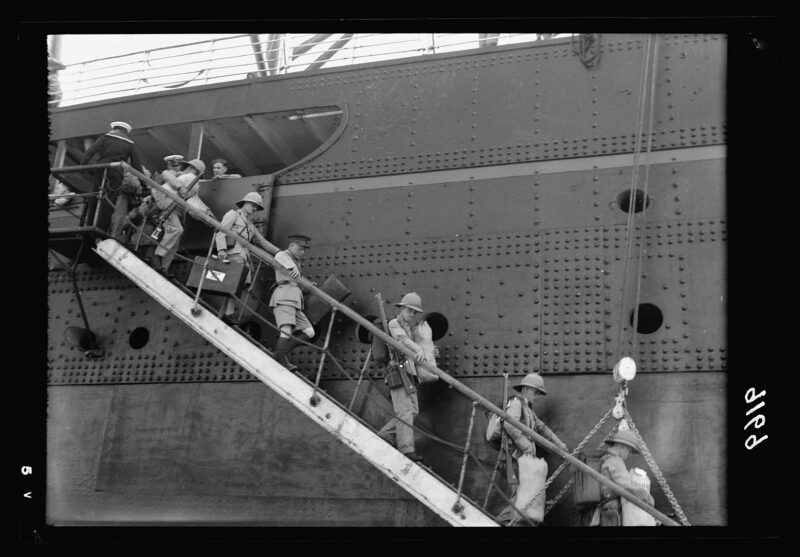
Palestine disturbances 1936. British troops parading on Jerusalem Street, taken inside Jaffa Gate Abstract/medium: G. Eric and Edith Matson Photograph Collection. By Matson Collection – Library of Congress Catalog. Original url. 18167, Public Domain. Wikimedia Commons. Fair use.
The ongoing war between Palestine and Israel has been a major source of tension for decades. For many of us not directly involved, it can feel distant and removed from our daily lives. However, this changed for me when I discovered that my grandfather, David, had spent his teenage years in The Holy Land during the 1930s. This revelation inspired me to delve deeper into the region's history, politics, and people during this critical period.

Palestine 1936 book cover
Oren Kessler’s book, Palestine 1936: The Great Revolt and the Roots of the Middle East Conflict, offers valuable insights into the tragedies and human stories in the 1936-1939 Arab Revolt in Palestine. As one of the first books of general interest on this critical period, it serves as a timely reminder of the immense suffering on both sides.
The “Arab Revolt” was a significant armed struggle between Palestinian Arabs and the British authorities, sparked by tensions between Arab leaders and Jewish immigrants settling in the region. Kessler's work highlights the importance of understanding and empathy as essential components in pursuing a peaceful resolution to the ongoing dispute.
I first came across the 1936-1939 Arab Revolt in Palestine when my dad’s step-sister discovered an old box of my grandfather’s belongings. It was like a scene from a movie. The box contained a jambiya, a dagger commonly worn throughout the Arab World; a 1934 edition of TE Lawrence’s Seven Pillars of Wisdom; postcards from British-controlled Palestine sent to Scotland, and, an old black and white, carefully annotated photo album. The album held photos taken by my grandfather, then aged 17-19, throughout the Holy Land: the old city of Jerusalem, Bethlehem, Nablus, and Galilee.

David Sheldrick, featured in a vintage photograph from the 1930s, serving in the British army in Palestine. The photo was found in the author's grandfather's collection, used with permission.
As I delved into my grandfather's past, I learned that he joined Scotland’s Black Watch in search of economic opportunities and was sent in 1937 to British Mandatory Palestine to quell social unrest. The unrest had been sparked in 1936 by the Arab Higher Committee’s call for a general strike and civil disobedience, led by the then Mufti of Jerusalem, Haj Amin al-Husseini, in response to perceived British pro-Zionist policies.
Finding books about the “forgotten insurgency,” as referred to by Kessler on page 3, proved challenging. Most publications focused on the later conflict in 1948 when the British withdrew, leading to the displacement of around 700,000 Palestinians, accounting for about 85 percent of the Palestinian population in the territories that became the State of Israel.
My grandfather rarely shared his firsthand experiences with his family or anyone else before his passing. This was common among World War II-era British soldiers due to a culture of silence, a stigma against discussing emotional struggles, and a feeling of dislocation and misunderstanding from their families.
Thus Palestine 1936 proves to be a valuable and accessible resource that provides a digestible account of the events, motivations, identities, and backgrounds of critical players. It is an engaging read regardless of background knowledge, offering insights into how British control of the region and their decisions led to tensions in the 1930s.

Photos from the author's grandfather's collection, showing his time serving in the British army in Palestine in the 1930s, used with permission.
The volatile years in Palestine: British actions, Jewish immigration, and Arab resentment
The Balfour Declaration of 1917 expressed British support for a “national home for the Jewish people” in Palestine, but also stipulated the protection of civil and religious rights of existing non-Jewish communities in Palestine.” Simultaneously, the British had strategic and economic interests in the region beyond their commitment to Zionism.

The British army in Palestine in the 1930. Photo from the author's grandfather's collection, used with permission.
During World War I, the British promised support for Arab nationalism and independence in exchange for Arab support. However, Kessler notes that these assurances were not the sole cause of hostilities, and the aspirations of both sides could have been complementary under different circumstances (p. 41).
In response to the persecution of Jews in Europe and the closure of many countries, including the United States, to Jewish migrants, Jewish migration to the region increased dramatically in the 1920s and 1930s. For example, between 1925 and 1930, the number of Jewish arrivals equaled the number from the previous two decades combined (p. 23).
Tensions between Jews and Arabs in Palestine escalated because of various factors, including increased Jewish immigration, historical land ownership and economic competition, political aspirations, and cultural differences. This led to a growing sense among the local Arab population that their lands, resources, and livelihoods were under threat.

Palestine disturbances 1936. British officers coming down the gangway off the S.S. Dorsetshire [Haifa] Abstract/medium: G. Eric and Edith Matson Photograph Collection. By Matson Collection – Library of Congress Catalog Public Domain. Wikimedia Commons. Fair use
During the 1936-1939 Arab Revolt in Palestine, additional troops were sent to the region (my grandfather, David, being one of them). They deployed harsh counterinsurgency measures (p. 157). However, the British decision to restrict Jewish immigration through the “white paper” policy of 1939 added tension to an already volatile situation. This policy failed to address the concerns of both Jews and Arabs, closing off the possibility of a Jewish homeland in Palestine for Zionists and infuriating the Arab population who saw it as British favoritism towards the Jewish community at their expense.

Photos from the author's grandfather's collection, showing his time serving in the British army in Palestine in the 1930s, used with permission.
The road to tragedy: Palestine 1936 and its lasting impact
Tensions between Jews and Arabs persisted throughout World War II. In 1947, the UN voted for the partition of Palestine into separate Jewish and Arab states. The Jews accepted the plan, but the Arab leaders rejected it, viewing it as a violation of their rights and interests, leading to the 1948 Arab-Israel War after the British withdrawal. The conflict had far-reach consequences for Palestine and the whole region.

Three soldiers in the British army. Palestine in the 1930. Photo from the author's grandfather's collection, used with permission.
Kessler sees the 1936-1939 Arab Revolt in Palestine as a decisive conflict, a precursor to the first Intifada, a series of uprisings in the West Bank and Gaza Strip in 1987. He argues that the Arab revolt played a significant role in setting the stage and shaping the outcome of the later conflicts of 1947-48. It marked “a story of two nationalists and the first major explosion between them” (p.2).
The heart of the Palestine 1936 conflict was marked by a pervasive sense of tragedy for all parties. The Jewish people, who had long suffered persecution, sought a secure haven but struggled to find it. The Palestinian Arabs, on the other hand, were compelled to make “morally outrageous” sacrifices to alleviate the persecution of another group, which they saw as a “miserable evasion” of the civilized world's duty to address the underlying issues, according to George Antonius, an Arab writer and nationalist (p. 167). This tragedy was compounded by the fact that the Palestinians were uprooted, displaced and lost their indigenous home.
The tragedy of the British is also evident in the Palestine 1936 conflict, as their motivation to safeguard their empire, had calamitous consequences. The conflict resulted in the deaths of thousands of Arabs, Jews, and British soldiers who were not as lucky as my grandfather (p. 211).
Indeed, the personal stories of individuals such as David Ben-Gurion, Israel's first prime minister following the declaration of the establishment of Israel in 1948, and Musa Alami, a prominent Palestinian Arab intellectual, provide a poignant throughline in Palestine 1936, showcasing the humanity and tragedy of the situation. The book portrays their intersecting paths and the series of meetings they had in 1934 (p. 38), hinting at the possibility of Jews and Arabs coexisting.

Press photograph from the Great Arab Revolt 1936-39. Photographs portraying Arabs arrested by the British police for having arms found in their possession, 5.4.1939. Kedem, Public Domain, Wikimedia Commons. Fair use.
The book also exposes the colonial mindset of the British rulers who saw themselves as saviors of the “natives,” (p. 48), while using brutal tactics, including collective punishment, demolition of homes, and excessive use of force (p. 157). As Kessler observes, today “when Israeli troops detain suspects without charge, raise checkpoints, and raze homes, they rely on tactics and laws inherited from their British forerunners” (p. 7).
Palestine 1936 is a compelling and important story that sheds light on a neglected chapter of history, given the ongoing unresolved dispute and frequent outbreaks of violence in the region. Kessler has done a tremendous service by bringing it to light.
Every time I revisit my grandfather's photo album, I’m haunted by an image of a man lying on the ground, presumably dead, labeled “a good rebel.” It is a reminder that the conflict in The Holy Land is not a distant, abstract issue. The human toll continues to grow, and it demands the world's attention.







